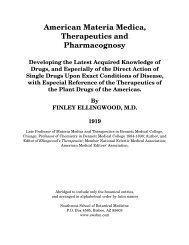SCARLET FEVER. Synonyms.—Scarlatina; Scarlet Rash. Definition ...
SCARLET FEVER. Synonyms.—Scarlatina; Scarlet Rash. Definition ...
SCARLET FEVER. Synonyms.—Scarlatina; Scarlet Rash. Definition ...
You also want an ePaper? Increase the reach of your titles
YUMPU automatically turns print PDFs into web optimized ePapers that Google loves.
Fibroid Phthisis.—<strong>Definition</strong>.—Fibroid phthisis is that condition<br />
where the normal lung" tissue is replaced by fibrous connective tissue,<br />
resulting in contraction and induration, and where a microscopic<br />
examination reveals tubercle. Chronic interstitial pneumonia is now<br />
classed as fibroid phthisis, there being no tubercle present, at least not<br />
till near the end of the disease.<br />
Pathology.—The replacement of lung substance by connective tissue<br />
usually begins in the apex, more rarely in the middle lobe, and<br />
gradually extends downward till the whole lung is involved. As the<br />
disease progresses, the lung becomes contracted and indurated. As a<br />
result of this, the chest of the affected side becomes flat, and the<br />
shoulder drops. But one lung may be affected, the opposite fellow<br />
becoming hypertrophied as a compensation. There is often dilatation of<br />
the larger bronchi and thickening of the pleura.<br />
Symptoms.—The symptoms depend, to some extent, on the manner in<br />
which it begins. Thus Clark Hadley and Chaplin describe three forms of<br />
the disease: first, a pure fibroid phthisis, where no tubercle exists;<br />
second, a tuberculo-fibroid, where the tubercle develops first, to be<br />
followed by the connective tissue; and, third, the fibro-tubercular form,<br />
where the tubercle follows the fibroid change.<br />
Cough is one of the earliest and most persistent symptoms, coming- on<br />
in paroxysms, and attended by expectoration of a mucus, sero-mucus, or<br />
purulent material. The paroxysms are more persistent in the morning.<br />
There is but little if any fever. The patient gradually loses flesh and<br />
strength. There is some pain in the affected side, and dyspnea follows<br />
slight exertion.<br />
On inspection, we notice that the affected side is nat or sunken, and<br />
that the shoulder droops. Auscultation reveals a bronchial sound, while<br />
percussion gives more or less dullness, the result of induration and the<br />
effacement of the air-cells. Where tubercles are present the symptoms<br />
are similar, with the addition of a slight fever and a more purulent<br />
expectoration. Sweating is not so profuse in the fibroid form as in the<br />
ulcerative phthisis, but hemorrhages are more frequent and also more<br />
serious. Albumen is often present in the urine, and dropsy is frequently<br />
seen, especially of the feet, and occurs in the later stages. The disease is<br />
decidedly chronic, lasting from ten to thirty years.<br />
Diagnosis.—The diagnosis is not always easy. Coming on insidiously,<br />
The Eclectic Practice of Medicine - PART I - Infectious Diseases - Page 204

















